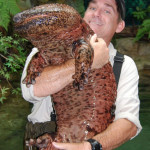The other day my husband asked if I wanted to go see hellbenders at a state park in Pennsylvania. I knew that hellbenders were salamanders, but I didn’t know much else about them. So I thought I’d learn something about them before we go in search of these unique creatures.
Eastern Hellbenders (Cryptobranchus allegoniensis), the only member of the giant salamander family found in North America, are large aquatic salamanders that can grow from 10 to 20 inches in length. They have wrinkled skin and their color varies from spotted yellowish to red and brown.
The Eastern Hellbender lives in fast-flowing, cold streams with rocky bottoms from southern New York to northern Georgia, but are most abundant in Pennsylvania, West Virginia, and Virginia. They are primarily nocturnal and spend most of their day hiding under logs or rocks. They like to eat snails and crayfish and are partial to worms, which sometimes leads to encounters with fishermen.
There are two common misconceptions surrounding this aquatic salamander—that it’s poisonous and that it spreads a slime on fishing lines that drives away fish. Both are untrue. The hellbender is harmless. But these misconceptions have led to nicknames such as devil dog and Allegheny alligator.*
Hellbenders have an interesting reproductive process. They mate late in the summer and the male then digs a shallow nest in the stream bottom beneath a log or rock. A female deposits 100 to 200 eggs in the nest as the male releases sperm to fertilize them. Dad then guards the nest for two to three months until the young hatch.
Hellbenders are considered a living fossil. They haven’t changed much since the Jurassic times, over 160 million years ago, which means they’ve been on Earth about 60 million years longer than humans. But human activity is causing them to decline dramatically in most areas.
Some causes for their decline include blocking of the animals’ migration routes, destruction of their aquatic habitat by dams and other development, as well as pollution, disease, and over harvesting for commercial and scientific purposes.
Here’s a National Geographic video about the hellbender. I wouldn’t try this at home (licking a salamander), but it does remind one that tasting really really bad is one of the defenses of animals like hellbenders.
Unike the hellbender in the video above, the hellbender in this video has been left undisturbed and despite its name, I think the hellbender is quite beautiful when you see it in its natural habitat:
*Most of the information in this post came from Longstreet Highroad Guide to the Pennsylvania Mountains by Greg and Karen Czarnecki.




